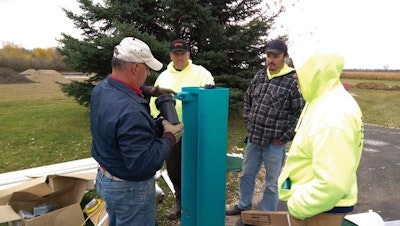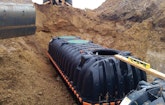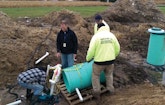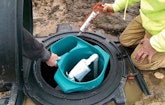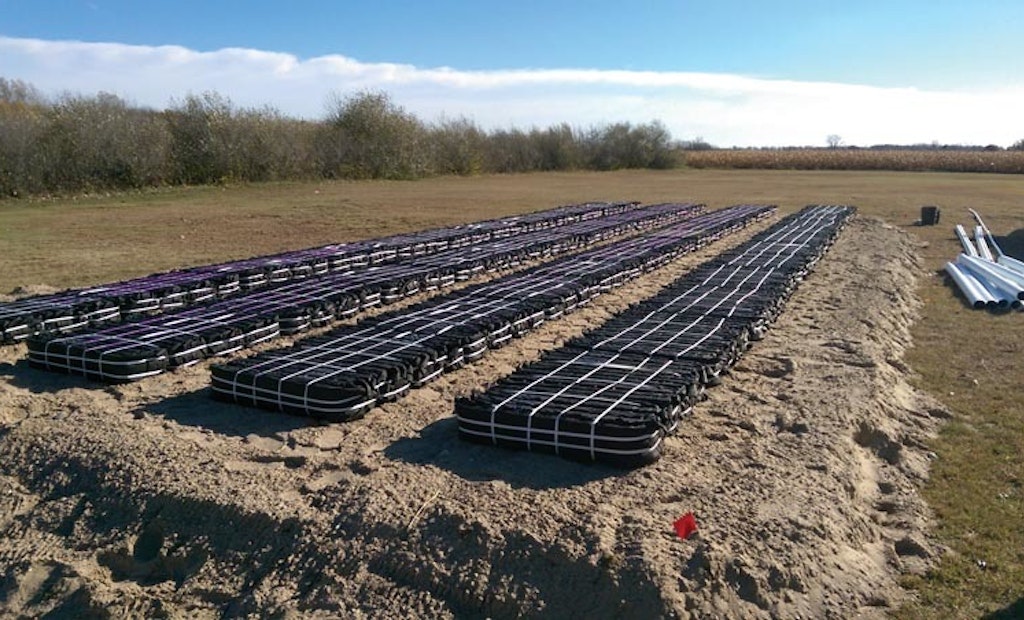
Interested in Pumps?
Get Pumps articles, news and videos right in your inbox! Sign up now.
Pumps + Get AlertsIt was past time to replace the aging onsite system at an assisted living facility in Auburn, Michigan. The building had been constructed as a grade school. The original system was pressure distribution on demand, says Joel Kwiatkowski, a registered sanitarian and the sewage treatment and water supply coordinator for the Bay County Health Department.
The old system had a drainfield made of bottomless concrete infiltration chambers, with pipes inside it and stone around the pipes. “And they collapse, and then the pipes plug up. And it’s an old, old system. I don’t even have plans on it.” The county’s oldest plans date to the late 1960s. He found one permit for the property dated 1971.
In 2013, the original system probably began failing. That’s Kwiatkowski’s guess, because it didn’t come to the county’s attention until a couple of months later when effluent began flowing into a ditch. Until a proper replacement could be designed and installed, the drainfield was abandoned. The septic tank was used as a holding tank, and wastewater was pumped out when the tank was full.
Newer and smaller
This was a relatively small project, so Kwiatkowski designed most of the replacement system himself, set the size parameters and then local engineering firm Axiom Consulting completed the drawings and detail work.
The collection pipe emerges from the south side of the facility, runs about 50 feet and discharges into two existing tanks, 3,000 gallons and 1,500 gallons. These tanks are connected by gravity flow and provide initial settling and treatment. Water flows out of the second tank through an Orenco Biotube filter and by gravity about 80 feet to a pair of 1,500-gallon Infiltrator poly tanks connected in series. These are for dosing and equalization.
A pair of Orenco Systems PF5005 vertical turbine pumps are set in the second of these two tanks and controlled by an Orenco panel set for time dosing. Kwiatkowski’s goal is 15 to 16 doses per day with a four- to six-hour rest period overnight. A 2-inch force main takes effluent to a Zoeller mechanical valve with four outlets. Only two are in use at the moment, with the remaining two available in case of future need. Pipe diameter drops to 1 1/4 inches coming out of the valve and heading to the manifolds. The Eljen units are fed by that 1 1/4-inch pipe placed inside perforated 4-inch pipe on top of the units.
The filter is composed of 48 Eljen GSF B-43 units divided into two zones and placed on top of 12 inches of 2NS coarse sand. The zones are placed 2 feet apart, 5 feet on center. On top of the zones and pipes is a layer of Eljen’s Geotextile fabric. On top of the fabric is 6 inches of sand, and on top of the sand is 4 inches of topsoil. The zones occupy a rectangle 18 feet wide by 48 feet long.
Frost line
Because this property is in the east-central part of Michigan’s lower peninsula, pipes are laid to drain so no water remains inside them to freeze. The Zoeller valve is above the manifold so it also drains. Any components that hold water above the frost line are insulated, Kwiatkowski says.
The Eljen system works well in his area, Kwiatkowski says. The seasonal water table is only 12 to 18 inches below grade. Stone beds require a great deal of hauling and must be very large because the soils are mostly fine sand and of poor quality. The Eljen units provide treatment, and the sand below them provides more treatment, he says. Moreover, the units and poly tanks can be brought in on a trailer. Heavy equipment is not required except for moving the sand, and this system requires smaller beds so there is less transportation cost. They must be installed properly, he says. Their bottoms cannot remain wet, or anaerobic digestion begins and sand filters may become plugged.
The work was done by Brian and Gary Garbulinski, who are with their father’s company, Walt’s Trucking and Excavating, in Pinconning, Michigan. They used a Komatsu PC40 excavator and a Case 580L backhoe on the job.
“There was a lot of water coming in by the septic tanks because the water table is high there, but it was all surface water,” Brian says. They dug a wider hole and tapered the sides for safety, then pumped it out. Once the hole was dry, there weren’t any more issues complicating the installation.
“Everything went in easily. The digging wasn’t bad because it’s a sandy soil,” Gary says.
He says he’ll be interested in seeing how the valve works placed above the frost line. “We packed foam peanuts in there for insulation, and it shouldn’t freeze.’’
Conserving first
One preventive measure that took place above ground was a change in the facility’s fixtures. At the time the system failed the facility was using about 3,000 gallons of water per day, as measured by a flowmeter Kwiatkowski required on the well serving the building. He suggested low-flow toilets, faucets and showerheads. The owner installed those, and consumption dropped to 800 gallons per day. By spending a couple thousand dollars on new fixtures, the facility owner saved thousands of dollars on the project because the footprint of the new drainfield could be reduced, Kwiatkowski says.
The system is also slightly larger than would otherwise be called for because of the nature of the facility. The people served there take medications, and that means pharmaceutical traces in the wastewater. Kwiatkowski says he took that into account, used slightly larger Eljen units and generally increased the size of the system to process the pharmaceutical waste.
Kwiatkowski’s design provides flexibility. If the facility expands or one of the zones partially fails, another zone can be easily added and connected to one of the unused outlets on the Zoeller valve. Laying the 1 1/4-inch pipe inside 4-inch provides easy maintenance access. Replacing a pressure line requires opening just the end of one zone, not opening the entire filter.
Kwiatkowski calls this a forever system. The components are less subject to failure than older systems, and anything that does fail can be easily replaced. “And we’re providing treatment. Instead of getting rid of water, we’re treating it.”
